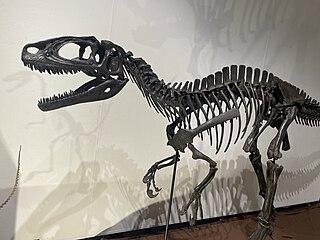
Fukuiraptor was a medium-sized megaraptoran theropod dinosaur of the Early Cretaceous epoch that lived in what is now Japan. Fukuiraptor is known from the Kitadani Formation and possibly also the Sebayashi Formation.
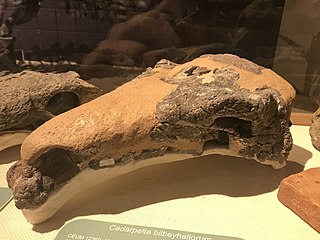
Cedarpelta is an extinct genus of basal ankylosaurid dinosaur from Utah that lived during the Late Cretaceous period in what is now the Mussentuchit Member of the Cedar Mountain Formation. The type and only species, Cedarpelta bilbeyhallorum, is known from multiple specimens including partial skulls and postcranial material. It was named in 2001 by Kenneth Carpenter, James Kirkland, Don Burge, and John Bird. Cedarpelta has an estimated length of 7 metres and weight of 5 tonnes (11,023 lbs). The skull of Cedarpelta lacks extensive cranial ornamentation and is one of the only known ankylosaurs with individual skull bones that are not completely fused together.
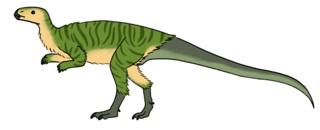
Changchunsaurus is an extinct genus of small herbivorous dinosaur from Early Cretaceous deposits of Gongzhuling, Jilin, China. It is the first named dinosaur genus from Jilin.

Jiangshanosaurus is a genus of herbivorous titanosauriform sauropod dinosaur that lived in China approximately 92-88 million years ago, during the Turonian-Coniacian stage of the Late Cretaceous.

Zhejiangosaurus is an extinct genus of ankylosaurian dinosaur from the Upper Cretaceous of Zhejiang, eastern China. It was first named by a group of Chinese authors Lü Junchang, Jin Xingsheng, Sheng Yiming and Li Yihong in 2007 and the type species is Zhejiangosaurus lishuiensis. It has no diagnostic features, and thus is a nomen dubium.

Dongyangosaurus is a genus of titanosaurian sauropod dinosaur from the Late Cretaceous. The only species is Dongyangosaurus sinensis, from which only a single fragmentary skeleton is known, coming from the Zhejiang province of eastern China. It was described and named by Lü Junchang and colleagues. Like other sauropods, Dongyangosaurus would have been a large quadrupedal herbivore.

Bolong is a genus of iguanodontian dinosaur known from the Early Cretaceous-age Yixian Formation of western Liaoning Province, China. It lived about 125 million years ago in the earliest Aptian.

Ahshislepelta is a monospecific genus of ankylosaur dinosaur from New Mexico that lived during the Late Cretaceous in what is now the Hunter Wash Member of the Kirtland Formation. The type and only species, Ahshislepelta minor, is known only from an incomplete postcranial skeleton of a small subadult or adult individual. It was named in 2011 by Michael Burns and Robert M. Sullivan. Based on the size of the humerus, Ahshislepelta is larger than Pinacosaurus mephistocephalus but smaller than Talarurus and Pinacosaurus grangeri.
The Khok Kruat Formation is a rock formation found in northeastern Thailand. It is the uppermost formation of the Khorat Group. It is dated to the Aptian stage of the Early Cretaceous period, and is notable for its fossils of dinosaurs. It is equivalent to the Gres superieurs Formation of Laos. The group is a fluvial formation consisting primarily of red siltstones and sandstones.
Dongyangopelta is an monospecific genus of nodosaurid dinosaur that lived in China during the Early to Late Cretaceous period in what is now the Chaochuan Formation. The type and only known species, Dongyangopelta yangyanensis, is known from a partial postcranial skeleton preserving osteoderms and ossified tendons. It was named in 2013 by Rongjun Chen, Wenjie Zheng, Yoichi Azuma, Masateru Shibata, Tianling Lou, Qiang Jin and Xinsheng Jin. Dongyangopelta represents one of the only nodosaurids known from Asia, along with Taohelong and Sauroplites.

Mosaiceratops is a genus of ceratopsian, described by Zheng, Jin & Xu in 2015 and found in the Xiaguan Formation of Neixiang County. Mosaiceratops lived in the upper Cretaceous in what is now the Henan Province of China.
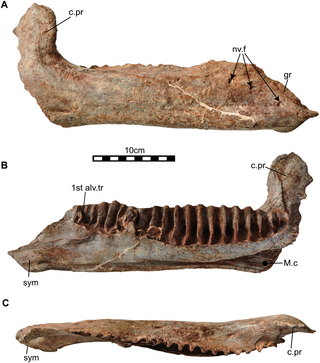
Sirindhorna is a genus of hadrosauroid ornithopod dinosaur from Early Cretaceous deposits of northeastern Thailand.

Jinyunpelta is a genus of herbivorous ankylosaurine thyreophoran dinosaur from the Cretaceous Liangtoutang Formation of Jinyun County, Zhejiang, China; it has one species, the type species J. sinensis. This species is the basalmost ankylosaur known to have had a proper tail club.
The Liangtoutang Formation, also referred to as the Laijia Formation is a geological formation located in Zhejiang, China. Its strata date back to the Albian to Cenomanian stages of the Cretaceous period. The lithology primarily consists of red sandstone.
Siamraptor is an extinct genus of carcharodontosaurian dinosaur, containing the single species S. suwati, known from the Khok Kruat Formation of Thailand. It is the first definitive named carcharodontosaurian species known from Southeast Asia.
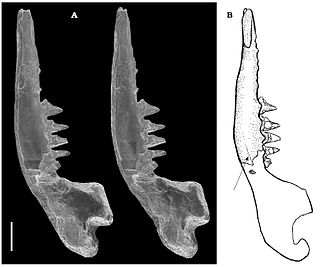
Symmetrolestes is an extinct genus of small spalacotheriid mammal from the Early Cretaceous period of Japan. The genus contains one species known as S. parvus, the type fossil is from fluvial deposits located in the Dinosaur Quarry in the Kitadani Formation, near the city of Katsuyama which lies alongside valley of the Sugiyamagawa River. It was described by Tsubamoto and Rougier in 2004 keeping the holotype at the National Science Museum, Tokyo, Japan.
The Chaochuan Formation is a geologic formation in China. It is made up of purplish red calcarenaceous, muddy siltstone, fine-grained sandstone with interbeds of tuffaceous sandstone and conglomerate or rhyolitic tuff.
The Fangyan Formation is a geologic formation in China (Dongyang). It is made up of mainly conglomerates. It preserves dinosaur fossils dating back to the Late Cretaceous.

Dzharatitanis is a genus of sauropod from the Bissekty Formation in Uzbekistan, dating to the Turonian age of the Late Cretaceous. The genus contains a single species, Dzharatitanis kingi, named after geologist Christopher King, who contributed to the Cretaceous geology of Asia. It is currently one of two known sauropods from the Bissekty Formation, alongside an indeterminate titanosaur. In its original publication it was considered to be a member of Rebbachisauridae, but later papers considered it to be a titanosaur.

Datai is an extinct genus of ankylosaurid dinosaur from the Late Cretaceous Zhoutian Formation of Jiangxi Province, China. The genus contains a single species, D. yingliangis, which is known from the articulated skulls and partial skeletons of two individuals.

















